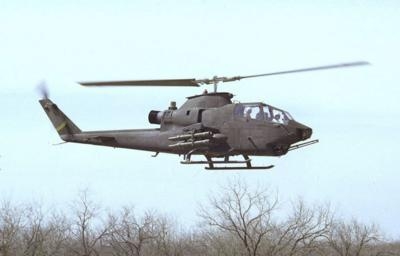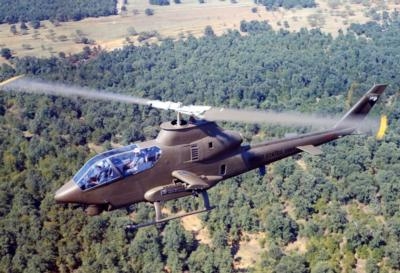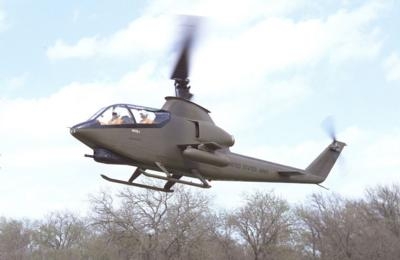Ushered In A New Era Of Attack Helicopters
Bell Helicopter this week is celebrating the 50th anniversary of the first flight of the Bell AH-1 Cobra.

The aircraft first flew on September 7, 1965 at Amon Carter Field. The trailblazing AH-1 is the original attack helicopter whose design and configuration Bell say defined attack helicopters to follow for decades after that first flight.
“During the last fifty years, the AH-1 Cobra has undergone multiple modifications and upgrades, continuing to build its notable track record of preserving our freedom and becoming one of the most prominent helicopters in the world,” said Michael Miller, Director of Military Business Development for Bell Helicopter and former Cobra pilot with the U.S. Army. “The longevity of this lethal armed helicopter can be largely attributed to its versatile design, originally conceived and produced in less than 18 months in the 60’s in response to urgent wartime needs. Every tandem attack helicopter you see today is born out of what the Bell Helicopter engineers were doing half a century ago. We are proud to recognize the Cobra as one of Bell Helicopter’s greatest achievements and honor the line’s five decades of faithful service.”
The United States Army launched the Advanced Aerial Fire Support System (AAFSS) competition in the mid 1960’s, with the goal for manufacturers to design an aircraft which met the Army’s immediate need for a fast, armed attack helicopter.
”We had a skunk works back in the day, but it was just a steam room where we were building the first fuselage,” said Dr. Mike Mikel, former Bell Helicopter vice president of Engineering and also a former Cobra pilot for the Army. “We were starting to design it, and someone asked how wide we ought to make the fuselage. Someone else pointed out the door to the room we were in was just over 36 inches, so that is how we ended up with a 36 inch wide fuselage. Having such a narrow target ended up to be a decisive advantage for the AH-1 when it was heading into hostile territory. We used to joke that it was easy to get into the cockpit, but that climbing back out was sometimes the hardest part of the mission.”

Within days of completing the mockup, a team of 30 Bell Helicopter engineers began designing and building the AH-1 Cobra prototype. After just six months, on Sept. 7, 1965, test pilot Bill Quinlan made the first flight of the AH-1 at Bell’s flight test facilities at what was the time Amon Carter Field. Shortly following the successful first flight the U.S. Army awarded Bell Helicopter its first contract for two pre-production helicopters. Four days later, the U.S. Army awarded a second contract for 110 production aircraft. By the end of the year, Bell Helicopter had earned contracts for approximately 500 AH-1 aircraft.
Bell Helicopter engineers designed a fuselage mockup for the competition which featured a revolutionary forward cockpit that seated the co-pilot/gunner in front of the pilot, and retractable landing skids that helped streamline the aircraft for even greater airspeed. The improvement provided an incredible increase in visibility for the pilot and the gunner, and tandem seating also contributed to greater situational awareness. This now-familiar configuration has been perpetuated in attack helicopter design ever since.

To date, the Cobra is acclaimed for serving as the backbone of the United States Army’s attack helicopter fleet during the Vietnam War. The latest version of the Cobra, the AH-1Z “Zulu,” is currently in service with the U.S. Marine Corps and is regarded as one of the world’s most advanced attack helicopters. More than 7,000 AH-1 models have been built and are still in production at Bell’s manufacturing plant in Amarillo, Texas.
“On a scale of one to ten, the Cobra was and still is a ten,” said Miller.
(Images provided by Bell Helicopter)
 ANN's Daily Aero-Term (05.16.24): Instrument Runway
ANN's Daily Aero-Term (05.16.24): Instrument Runway ANN's Daily Aero-Linx (05.16.24)
ANN's Daily Aero-Linx (05.16.24) Airborne 05.15.24: Ghost Sq MidAir, B-2 Junked, Dream Chaser Readies
Airborne 05.15.24: Ghost Sq MidAir, B-2 Junked, Dream Chaser Readies Airborne 05.10.24: Icon Auction, Drunk MedEvac Pilot, Bell ALFA
Airborne 05.10.24: Icon Auction, Drunk MedEvac Pilot, Bell ALFA Airborne Affordable Flyers 05.16.24: PRA Runway, Wag-Aero Sold, Young Eagles
Airborne Affordable Flyers 05.16.24: PRA Runway, Wag-Aero Sold, Young Eagles





